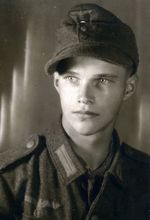Difference between revisions of "Sebastian Scheffler"
| Line 20: | Line 20: | ||
|- | |- | ||
|'''Rank''' | |'''Rank''' | ||
| − | | | + | |Feldwebel (Sergeant) |
|- | |- | ||
|'''Unit''' | |'''Unit''' | ||
| Line 93: | Line 93: | ||
! [[57th VS-Panzergrenadier Division Uckermark|57th VS-Panzergrenadier Division ''Uckermark'']] | ! [[57th VS-Panzergrenadier Division Uckermark|57th VS-Panzergrenadier Division ''Uckermark'']] | ||
|- | |- | ||
| − | | 2 April 1916 || '' | + | | 2 April 1916 || ''Feldwebel'' (Sergeant) |
|- | |- | ||
|} | |} | ||
Latest revision as of 04:36, 18 December 2018
| Sebastian Scheffler | |
| Sebastian Scheffler as a Schütze in early 1914 | |
| Born | 29 December 1893
Ernsbach, Rotgeheim |
| Allegiance | Rotgeheim |
| Service/branch | |
| Years of Service | 1914 – present |
| Rank | Feldwebel (Sergeant) |
| Unit | 57th VS-Panzergrenadier Division Uckermark |
| Battles/wars | Northern Territory War |
| Relations | Thorsten (father) Katharina Fiedler (mother) |
Sebastian Scheffler (born 29 December 1894) is a Rotgeheiman soldier most famous for his actions during the Northern Territory War, for which he was awarded several high honors.
Sebastian is related to Rotgeheiman generals Matthaeus Fiedler, commander of XI VS-Füsilierkorps, and Felix Fiedler, commander of 52nd VS-Panzer Division Mitternacht.
Contents
Early life and career
Sebastian Scheffler was born on 29 December 1894 in the village of Ernsbach. He was the firstborn of career soldier Thorsten and his wife Katharina Fiedler. He excelled in his studies throughout primary and secondary school, and passed his university entrance exam, although he opted not to attend. He instead worked at a local farm for a couple years, earning enough money to buy his own small apartment.
On 3 February 1914, Scheffler joined the Verteidigungsstaffel, citing his father's history as a soldier and his desire to serve his country as reasons. He was assigned to the 128th Infantry Regiment, 50th VS-Füsilier Division Kurland. After basic training concluded in March 1914, Scheffler was stationed at a coastal defense battery in Hausteck, Finnmarck, an island province in far northern Rotgeheim.
Northern Territory War
September 1914
Coastal Action
At the beginning of the Northern Territory War, Scheffler was stationed in a coastal defense bunker overlooking a section of beaches on the northern coast of Finnmarck. When the bombardment of the Rotgeheiman defensive positions began on 11 September, Scheffler was on his way to a forward observation bunker situated several hundred meters away from the waterline. Scheffler was supposed to report to his squad leader, Unteroffizier (Sergeant) Tillmann Niehaus in the observation bunker, but the naval bombardment destroyed many bunkers, killing Niehaus and nearly Scheffler as well.
As Scheffler frantically ran throughout the bunker complex to look for survivors, he ran into two soldiers attempting to lift fallen debris off a third, trapped soldier. Scheffler helped them free the trapped soldier, and the group of four together searched their section of the bunker complex for survivors. None were found.
The soldiers Scheffler encountered later accompanied him throughout the duration of much of the war. Two of them were airmen, a Rottenführer (Lance Corporal) Anton Streicher and Oberschütze (Private First Class) Timo Burkhardt. The third was a young Leutnant (Second Lieutenant) Peter Bethmann, who later became Scheffler's platoon leader because of the lack of experienced soldiers.
Scheffler and his group left the bunker complex and searched for friendly forces to link up with. After discovering a relief column that had been destroyed by enemy fighter-bombers, the group came upon troops of the 26th VS-Mountain Division Langemarck and were folded into the unit.
Scheffler, Streicher, and Bethmann (minus Burkhardt, who was taken away by medics after collapsing) continued with troops of Langemarck to outcroppings of rock and a wooden wall about a hundred meters from the waterline, where several landing barges were offloading Fuerstenburg troops. Scheffler and troops of Langemarck engaged the invading troops for about half an hour before they were overwhelmed, at which point they fell back to a small building. Scheffler, his group, and a few dozen surviving soldiers situated themselves in and around the building.
After a lengthy firefight with invading forces, many soldiers were forced to abandon the building, including Scheffler. He, Streicher, and Bethmann fled westward into a field, narrowly escaping an intense series of explosions that killed many of the occupants of the building. They continued westward, through a series of small villages, and linked up with a group Rotgeheiman soldiers from several units.
Summary of career
Awards
- Iron Cross
- Grade 1 (12 October 1914)
- Grade 2 (20 December 1914)
- Knight's Cross of the Iron Cross
- Grade 1 (28 May 1915) as Oberschütze (Private First Class) in 2nd Battalion, 128th Infantry Regiment, 50th VS-Füsilier Division Kurland
- Grade 1 (28 May 1915) as Oberschütze (Private First Class) in 2nd Battalion, 128th Infantry Regiment, 50th VS-Füsilier Division Kurland
- Distinguished Army Service Medal
- Grade 1 (28 May 1915)
- Wound Badge
- Grade 1 (16 November 1914)
- Grade 2 (3 May 1916)
- Northern Territory War Medal (19 September 1915)
- Finnmarck Campaign Medal (20 July 1915)
- Scheinfeld War Medal (20 May 1916)
- Füsilier Service Ribbon (5 August 1916)
- Panzergrenadier Service Ribbon (4 September 1916)
- 50th VS-Füsilier Division Kurland Service Badge (5 August 1916)
- 57th VS-Panzergrenadier Division Uckermark Service Badge (4 September 1916)
Promotions
| 50th VS-Füsilier Division Kurland | |
|---|---|
| 3 February 1914 | Schütze (Private) |
| 20 March 1914 | Oberschütze (Private First Class) |
| 22 December 1914 | Gefreiter (Lance Corporal) |
| 4 June 1915 | Obergefreiter (Senior Lance Corporal) |
| 57th VS-Panzergrenadier Division Uckermark | |
| 2 April 1916 | Feldwebel (Sergeant) |

